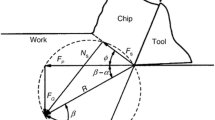Abstract
In recent years, the demands for micro components are increasing in various industries. Mechanical micromachining is one of the best fabrication methods for creating micro parts with complex dimensional features. However, in micromachining, the material microstructures, such as grain size, grain boundary, and crystallographic orientation, have significant influence on the machining process and the part’s quality. In this paper, a set of micromachining experiments were conducted on oxygen-free copper to investigate cutting force and burr formation affected by the material microstructures. The results showed that both the crystallographic orientation in single crystal material and the grain size in polycrystalline material have great effect on the cutting force and the burr formation.
Similar content being viewed by others
References
Chae J, Park SS, Freiheit T (2006) Investigation of micro-cutting operations. Int J Mach Tool Manuf 46:313–332
Chen MJ, Ni HB, Wang ZJ, Jiang Y (2012) Research on the modeling of burr formation process in micro-ball end milling operation on Ti–6Al–4 V. Int J Adv Manuf Technol 62:901–912
Zhang T, Liu ZQ, Xu C (2013) Influence of size effect on burr formation in micro cutting. Int J Adv Manuf Technol 68:1911–1917
Zhan ZB, Li L, He N, Shrestha R (2014) An experimental study on grinding parameters for manufacturing PCD micro milling tool. Int J Adv Manuf Technol 73:1799–1806
Dornfeld D, Min S, Takeuchi Y (2006) Recent advances in mechanical micromachining. CIRP Ann Manuf Technol 55:745–768
Camara MA, Campos RJC, Abrao AM, Davim JP (2012) State of the art on micromilling of materials, a review. J Mater Process Technol 28:673–685
Bissacco G, Hansen HN, Chiffre D (2006) Size effects on surface generation in micro milling of hardened tool steel. CIRP Ann Manuf Technol 55:593–596
Moronuki N, Liang Y, Furukawa Y (1994) Experiments on the effect of material properties on microcutting processes. Precis Eng 16:124–131
Mian AJ, Driver N, Mativenga PT (2010) A comparative study of material phase effects on micro-machinability of multiphase materials. J Adv Manuf Technol 50:163–174
Zhou M, Ngoi BKA, Zhong ZW, Wang XJ (2001) The effect of material microstructure on micro cutting processes. Mater Manuf Process 16:815–828
Simoneau A, Ng E, Elbestaw MA (2007) Grain size and orientation effects when microcutting AISI 1045 Steel. CIRP Ann Manuf Technol 56:57–60
Popov KB, Dimov SS, Pham DT, Minev RM, Rosochowski A, Olejnik L (2006) Micromilling: material microstructure effects. Proc Inst Mech Eng B J Eng Manuf 220:1807–1813
Liang Y, Moronuki N, Furukawa Y (1994) Calculations of the effect of material anisotropy on microcutting processes. Precis Eng 16:12–138
Ueda K, Iwata K (1980) Chip formation mechanism in single crystal cutting of brass. CIRP Ann Manuf Technol 29:41–46
Sato M, Yamazaki T, Shimizu Y, Takabayashi T (1991) A study on the microcutting of aluminum single crystals. JSME Int J Ser 34:540–545
Yuan Z, Lee W, Yao Y, Zhou M (1994) Effect of crystallographic orientations on cutting forces and surface quality in diamond cutting of single crystal. CIRP Ann Manuf Technol 43:39–42
Schueler GM, Engmann J, Marx T, Haberland R, Aurich JC (2010) Burr formation and surface characteristics in micro-endmilling of titanium alloys. Burr-analysis, Control and Removal: Proceedings of the CIRP International Conference on Burrs p129–138
Lee K, Dornfeld DA (2005) Micro-burr formation and minimization through process control. Precis Eng 29:246–252
Lee DE, Deichmueller M, Min S, Dornfeld DA (2006) Variation in machinability of single crystal materials in micromechanical machining. Lab Manuf Sustain 220:291–294
Min S, Lee DE, Grave DA, Valente CMDO, Lin J, Dornfeld DA (2004) Surface and edge quality variation in precision machining of single crystal and polycrystalline materials. Proceedings of the 7th International Conference on Deburring and Surface Finishing p341–350
Author information
Authors and Affiliations
Corresponding author
Rights and permissions
About this article
Cite this article
Wu, X., Li, L., He, N. et al. Investigation on the influence of material microstructure on cutting force and bur formation in the micro cutting of copper. Int J Adv Manuf Technol 79, 321–327 (2015). https://doi.org/10.1007/s00170-015-6828-5
Received:
Accepted:
Published:
Issue Date:
DOI: https://doi.org/10.1007/s00170-015-6828-5




